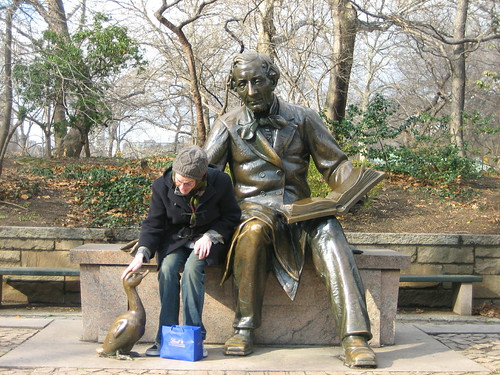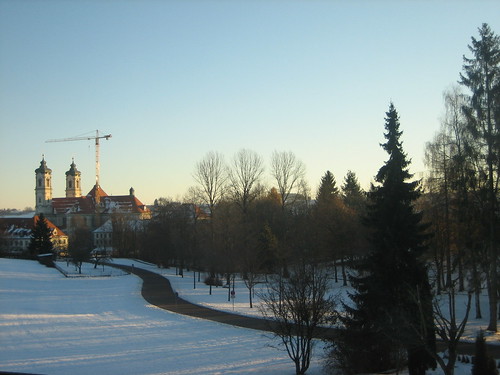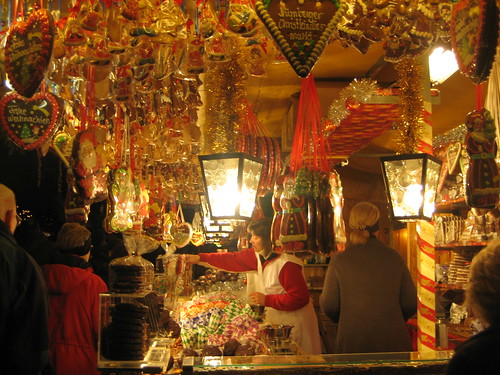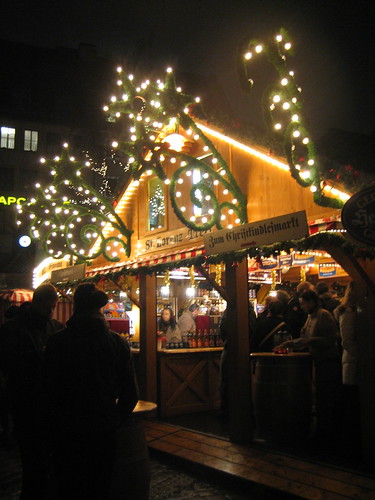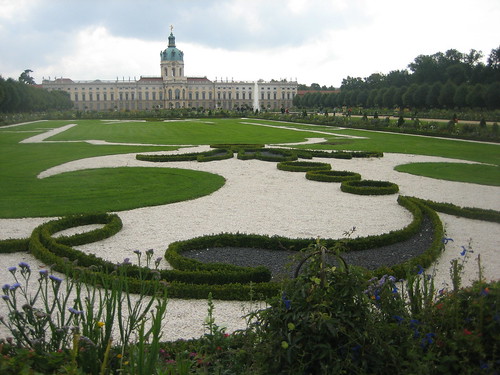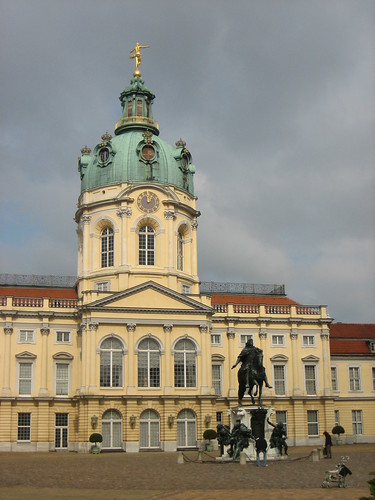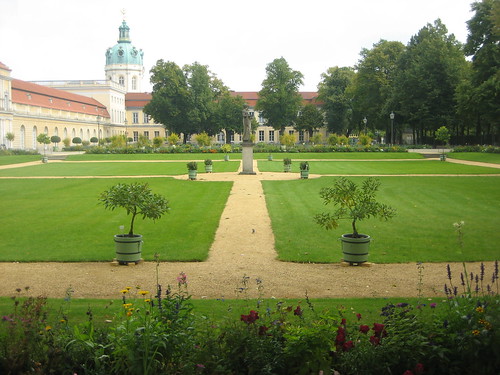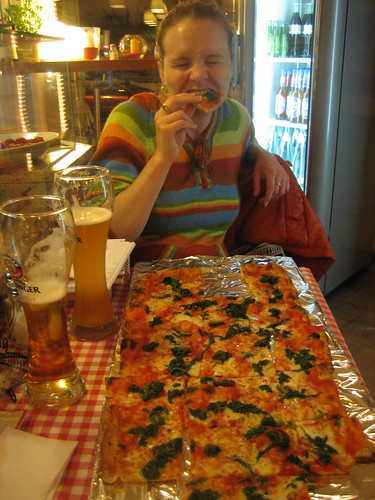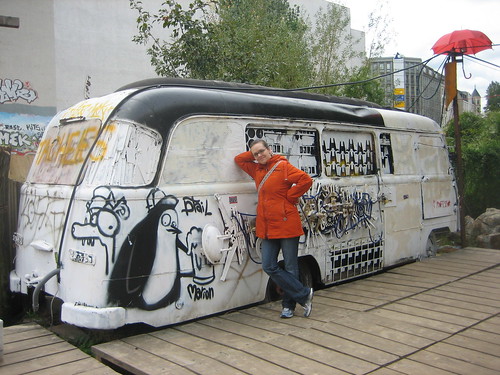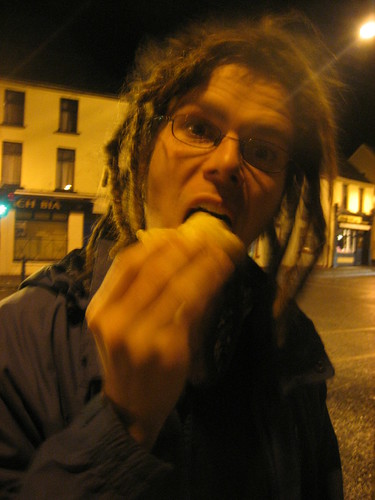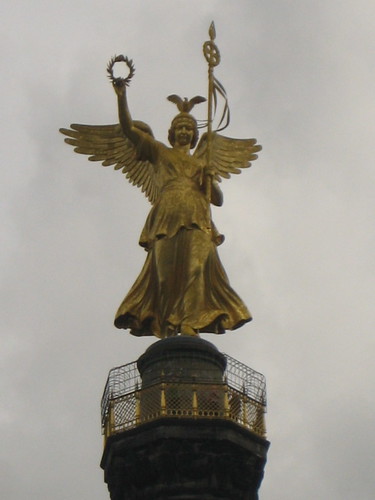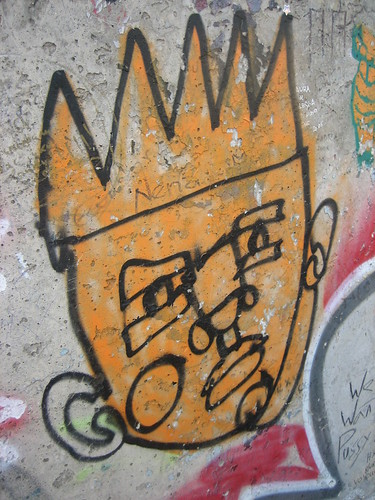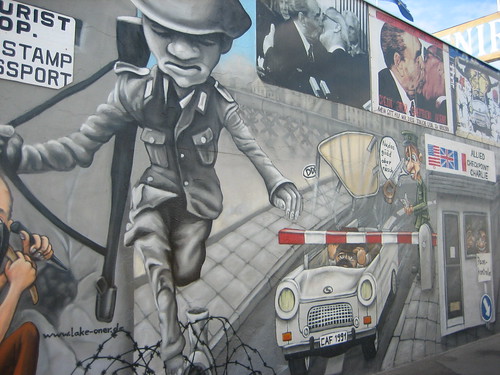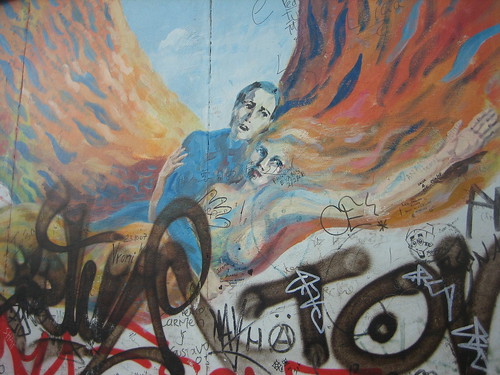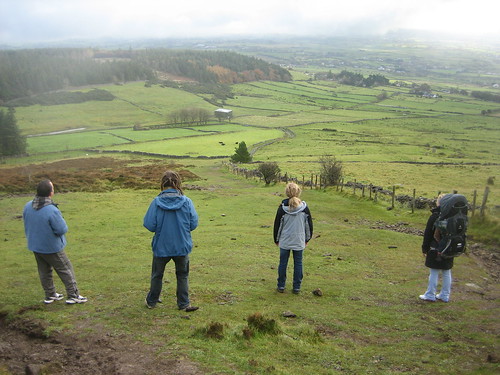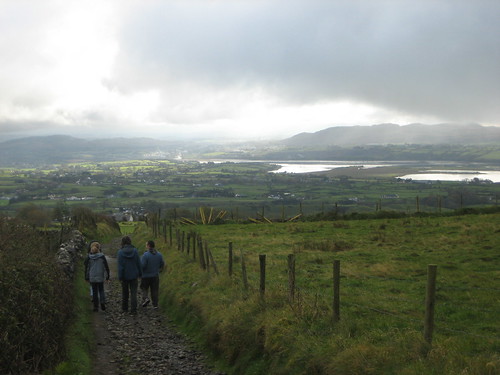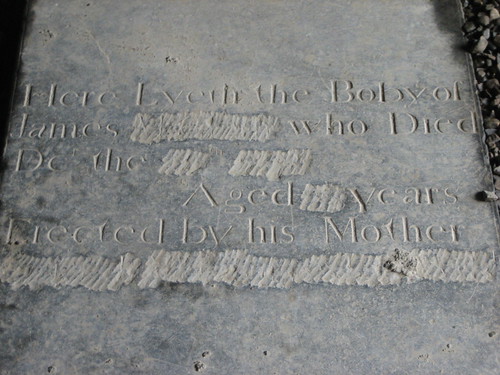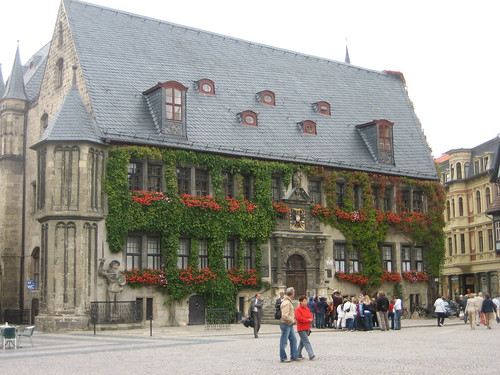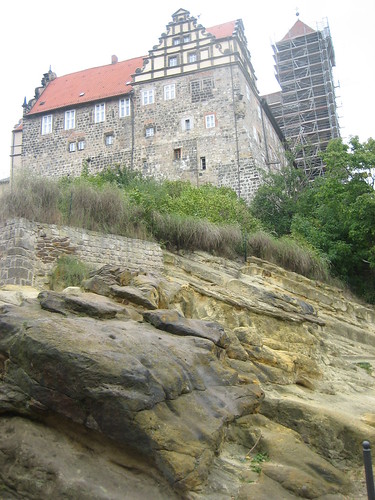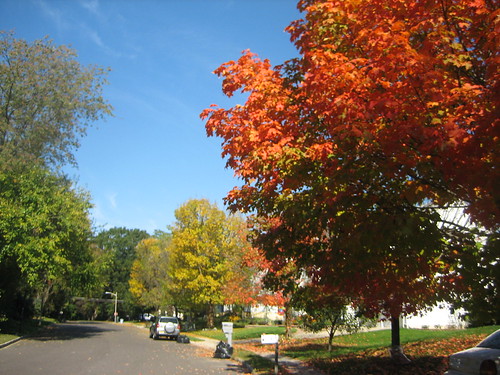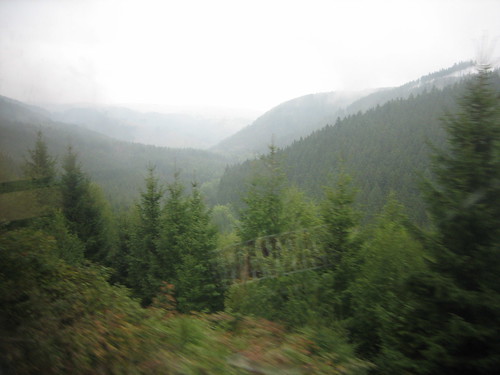Adventures in Germany: Nuremberg
 While in Nuremberg I got to the Albrecht-Dürer-Haus, which is on the opposite side of this square (the entrance to the Kaiserburg is to the left of this shot--I didn't get there this time, but I figure I'll be back!) I've loved Dürer's etchings since art history class in high school, and it was such a thrill to walk through the rooms he lived and worked in five hundred years ago.I also visited the Nazi party rally grounds, which I may blog about later. But for now, a couple more shots of the Christkindlesmarkt (a view of the Lorenzkirche, and the awesome hard candy stall where I picked up some chili chocolate candies for Brendan).
While in Nuremberg I got to the Albrecht-Dürer-Haus, which is on the opposite side of this square (the entrance to the Kaiserburg is to the left of this shot--I didn't get there this time, but I figure I'll be back!) I've loved Dürer's etchings since art history class in high school, and it was such a thrill to walk through the rooms he lived and worked in five hundred years ago.I also visited the Nazi party rally grounds, which I may blog about later. But for now, a couple more shots of the Christkindlesmarkt (a view of the Lorenzkirche, and the awesome hard candy stall where I picked up some chili chocolate candies for Brendan).
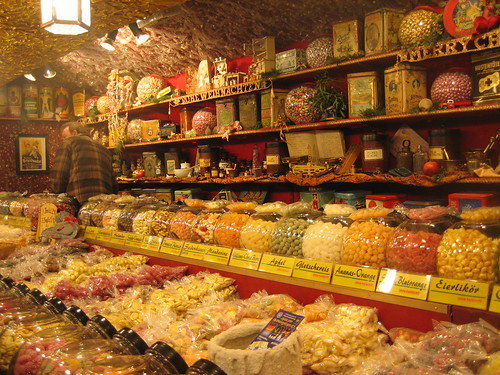
Adventures in Germany: Ottobeuren
My first stop in Bavaria was a little town called Ottobeuren, known for its huge Benedictine monastery. Here's an early-morning view of the basilica from my hotel window:
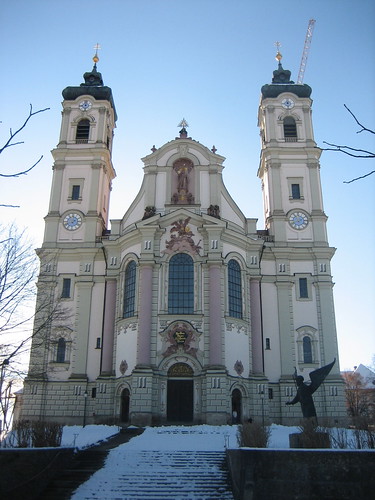
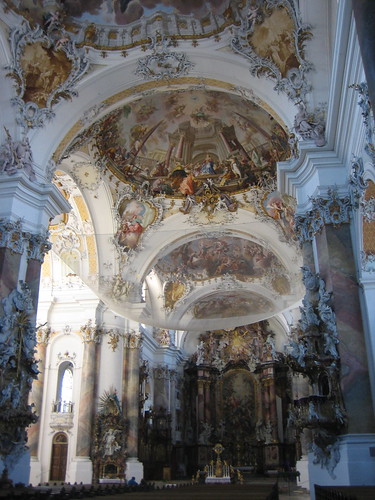 There are a couple reasons why I came here. I first heard about Ottobeuren while listening to A Spy at the Heart of the Third Reich: the most valuable Allied spy of World War II, Fritz Kolbe, stayed here for a few days and was able to photograph his documents in the perfect privacy of the monastery library. (The narrator pronounced it Ott-oh-byur-in, but the bus driver didn't understand me when I pronounced it that way. Apparently it's Ott-oh-bway-rin.)Anyway, I was intrigued by the monastery's description in the book, and when I googled it, I found another item of interest in the basilica: the complete skeletons of four obscure saints reclining in glass coffins, plus a lot of skulls and other bones in smaller glass cases (the skull of Saint Apollonia, for instance, is crowned with a wreath of jewels). Check out what's left of Saint Maurus below:
There are a couple reasons why I came here. I first heard about Ottobeuren while listening to A Spy at the Heart of the Third Reich: the most valuable Allied spy of World War II, Fritz Kolbe, stayed here for a few days and was able to photograph his documents in the perfect privacy of the monastery library. (The narrator pronounced it Ott-oh-byur-in, but the bus driver didn't understand me when I pronounced it that way. Apparently it's Ott-oh-bway-rin.)Anyway, I was intrigued by the monastery's description in the book, and when I googled it, I found another item of interest in the basilica: the complete skeletons of four obscure saints reclining in glass coffins, plus a lot of skulls and other bones in smaller glass cases (the skull of Saint Apollonia, for instance, is crowned with a wreath of jewels). Check out what's left of Saint Maurus below: I know, it's not a very detailed photograph, but I couldn't bring myself to take any pictures at close range. These glass coffins were horrifying and wonderful all at once. It made me wonder who had exhumed these early saints, wired their bones together, and dressed them in velvet so they could be displayed like this.According to the website, the monastery library and museum should have been open, but the door was locked and I was too timid to ask the lady at the gift shop if she spoke English. The sign said both gift shop and museum were closed for lunch, but lunchtime was over by the time I visited. I really should have asked, so that at least I would have known for sure that the museum was closed for the winter (or perhaps because of the construction). This is something I struggle with when I travel--this ridiculous timidity. I've come all this way...why not stick out my neck just a little bit further?Otherwise, Ottobeuren is a quiet, pleasant little town with a few spa-hotels. I was a bit taken aback when I checked my credit card bill to find my stay at the Hotel St. Ulrich was listed as "SANATORIUM OTTOBEUREN"! My room was adorable and cozy, and because I only really came to check out the church and monastery (and there wasn't much else to do anyway), I ended up spending quite a bit of time curled up with my laptop. It was a very productive trip.Here's a little shrine to St. Ulrich on the path from the church to the hotel:
I know, it's not a very detailed photograph, but I couldn't bring myself to take any pictures at close range. These glass coffins were horrifying and wonderful all at once. It made me wonder who had exhumed these early saints, wired their bones together, and dressed them in velvet so they could be displayed like this.According to the website, the monastery library and museum should have been open, but the door was locked and I was too timid to ask the lady at the gift shop if she spoke English. The sign said both gift shop and museum were closed for lunch, but lunchtime was over by the time I visited. I really should have asked, so that at least I would have known for sure that the museum was closed for the winter (or perhaps because of the construction). This is something I struggle with when I travel--this ridiculous timidity. I've come all this way...why not stick out my neck just a little bit further?Otherwise, Ottobeuren is a quiet, pleasant little town with a few spa-hotels. I was a bit taken aback when I checked my credit card bill to find my stay at the Hotel St. Ulrich was listed as "SANATORIUM OTTOBEUREN"! My room was adorable and cozy, and because I only really came to check out the church and monastery (and there wasn't much else to do anyway), I ended up spending quite a bit of time curled up with my laptop. It was a very productive trip.Here's a little shrine to St. Ulrich on the path from the church to the hotel: And here's Ottobeuren's Marketplatz by night:
And here's Ottobeuren's Marketplatz by night: My time here was wonderfully relaxing, and it was really neat to be able to walk the halls Fritz Kolbe walked sixty-odd years ago. I'm not sure yet how the visit will inform my fiction, but it certainly will somehow.Next post: Nuremberg and more pictures of the Christkindlesmarkt!
My time here was wonderfully relaxing, and it was really neat to be able to walk the halls Fritz Kolbe walked sixty-odd years ago. I'm not sure yet how the visit will inform my fiction, but it certainly will somehow.Next post: Nuremberg and more pictures of the Christkindlesmarkt!
Adventures in Berlin: Potsdam
More info on Potsdam here. Top photo: the charming brick townhouses of the Dutch Quarter. The rest of the pictures are from Sanssouci--that's the 18th-century Chinesisches Teehaus (Chinese Tea House) in the second and third photos.
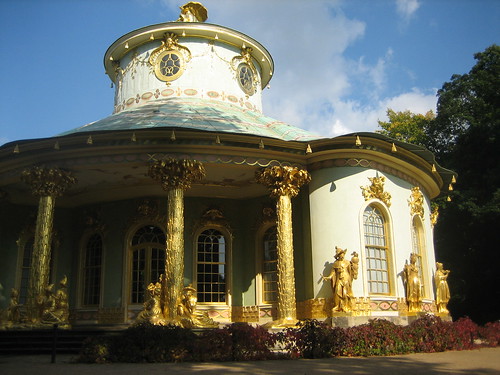
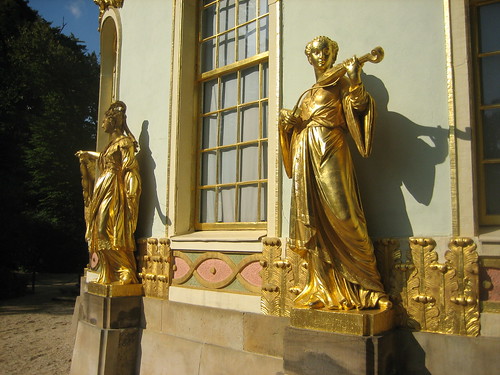

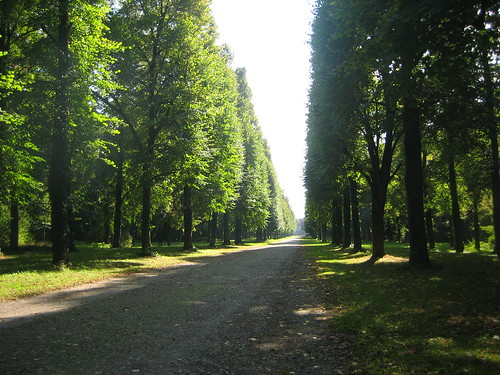
Adventures in Germany: Schloss Charlottenburg
Photos from a morning at the Charlottenburg Palace:
Adventures in Berlin: Where to Eat
I didn't have any trouble eating out in Germany as a vegetarian--even the restaurants in Wernigerode had surprisingly good veggie options. Here are a few recommendations (I dunno, maybe you can bookmark this post for when you plan your own trip to Berlin?)
If you happen to stay in Kreuzberg, try Amici Miei (Mehringdamm 40), a hole-in-the-wall pizzeria with very friendly service where we got this humongous (and delicious) spinach pie for €11.80 (cheap by Irish standards). Hard to believe, but we eventually polished it off.
But our favorite eatery (we ate there twice) was Malete, on Chausseestrasse 131 in the Mitte neighborhood. The Mediterranean and Middle-Eastern-inspired dishes there were absolutely to die for--even something as simple as fried eggs over sauteed veggies with a side of roasted potatoes. Or order anything with eggplant/aubergine in it. Our meals came with a basket of the tastiest fresh toasted bread spread lightly with a parmesan/red pesto sauce. Just writing about it now makes me want to scrap the Bavaria plan and return to Berlin instead!The last spot to recommend is in Potsdam, where I happened upon a terrific little vegetarian café close to Sanssouci called Café KieselStein (Hegelallee 23). Roasted pumpkin stuffed with feta and veggies, Asian-inspired soups made with coconut milk, homemade berry pies, organic local beers...great all-around, though the service was a bit slow. There seemed to be a lot of cute restaurants in the Dutch quarter too, but KieselStein was perfect after a long stroll through the park.
Adventures in Berlin: the Kunsthaus Tacheles
Guess what--I'm going back to Germany next week! Just for a week this time, to Bavaria, and I am really excited for the Christkindlmarkt in Nuremberg. I have five or six blog entries left for the first trip, so I'd better finish it up already. I'll schedule the last few to appear while I'm away. (I'm also trying to wrap up a draft of Petty Magic to send to my agent, so most of these last entries will be pretty much photos only.)Last week I posted a video clip of the unusual disco ball at the Kunsthaus Tacheles, definitely one of the coolest/weirdest spots in Berlin. Artists moved into this bombed-out department store after the fall of the Berlin Wall, and it has bars, a café, and a nightclub as well as artists' studios.You walk through an archway (handmade jewelry for sale beside an old van covered in graffiti, and set into the wall above are majestic stone figures dating to the building's first act) and out into an open sandy space with car seats set around picnic tables as well as random sculptures, all from found materials, like so:
There is graffiti on almost every surface, especially on the stairwells that lead to the studios and galleries upstairs. Alas, none of my interior or nighttime photos are good enough to show you.
This courtyard space felt like a playground for those of us who will never consider ourselves grown-ups.
Something else I didn't get a picture of was a huge rocket-shaped metal thingie in the yard that had a metal ladder (like you'd see inside a submarine) leading up to a dark round opening near the top. I told some of the people on our pub crawl (I had been there earlier in the day, and so could speak with authority) that it was known as The Vomit Rocket, and that they should climb up the metal ladder and do what they must, but fortunately nobody had had that much to drink.But my favorite part of all was in a hallway upstairs: a full-sized "photo booth" fashioned out of cardboard, with space for both the artist and his subject to sit. Along with a very modest price list, a sign read (in English):
(And there might have been a couple more, I can't remember now.) I only wish the artist had been in attendance.
AT LAST!
My epic quest for spudballs ended last night at approximately 6pm at Fats Quann's takeaway in Carrick on Suir.A spudball is a big blob of mashed potato and minced onion, fried in batter and sprinkled liberally with salt and vinegar. They're packaged first in a brown paper bag, then in newspaper, then in one of those ubiquitous blue and white striped plastic bags that is the hallmark of Irish mom-'n-pop fast food.
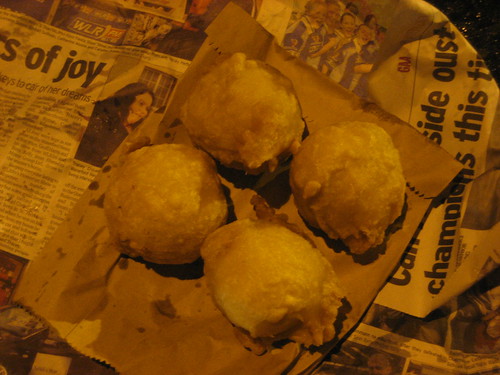 I have never heard tell of them anywhere besides Carrick on Suir, and as you may remember, the first two times I visited Brendan's family either the takeaway was closed or they were out of spudballs.
I have never heard tell of them anywhere besides Carrick on Suir, and as you may remember, the first two times I visited Brendan's family either the takeaway was closed or they were out of spudballs.
Greasy, mushy, salty goodness. Worth the wait? Oh baby!
Adventures in Berlin: Kunsthaus Tacheles, part 1
It's a ruin. It's a squat. It's a studio. It's a gallery. It's a playground. It's a café/bar. It's a club.It's a disco, baby.Proper entry soon.
Adventures in Berlin: good times at the beer tent
I forgot to include this little video Kelly took in my Fat Tire entry the other day. It was so much fun watching people of all ages dancing on tables.
Adventures in Berlin: the Holocaust Memorial
Kelly and I visited the Memorial to the Murdered European Jews two times, on our own and then the following day with the Fat Tire bike tour. Both times we found ourselves really frustrated by the hordes of teenagers who showed zero respect for the monument or the millions of Holocaust victims it memorializes.
This is not an amusement park. This is not a novelty. It is not appropriate to laugh loudly, play hide-and-seek, or chase each other on your bicycles.
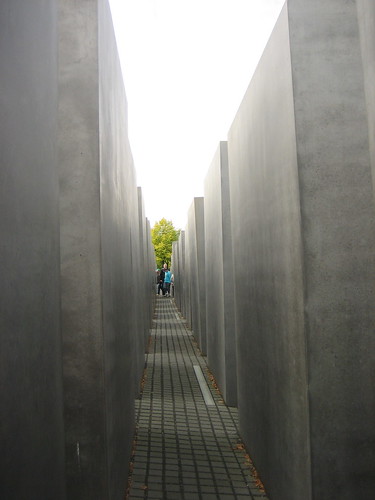 At least they had enough decency to look sheepish when Kelly admonished them.
At least they had enough decency to look sheepish when Kelly admonished them.
I know I'm sounding like an old crank here, but it's because I remember what it was like to be fifteen that I felt so justified in deploring their behavior. If this monument had existed when I was fifteen and I visited it on a school trip, I would have walked through it on my own, in silence, feeling both sad and hopeful that the atrocities of which this monument is a reminder will never be repeated.
Adventures in Berlin: Fat Tire (and Happy Birthday to Me!)
 Right: the ruins of the Kaiser Wilhelm Memorial Church.Seanan beat me to Berlin by a couple of months, so he was able to point me to a few things of particular interest. He recommended a biking tour of the city with Fat Tire, and let me tell you, it was definitely one of the highlights of our trip to Germany. The tour guides at Fat Tire are brilliant--they all have degrees in German history, but they certainly know how to have a good time (as you would expect, they tend to be ladies' men). Our tour was supposed to last four hours, but it took almost six--I was so impressed that on top of a tremendously informative and entertaining tour, our guide wasn't rushing us back to the starting point so he could get on with his day. If you're going to Berlin, London, Paris, or Barcelona anytime soon, definitely check out their website to see if any tours fit your schedule. Thirty bucks (€20, and we also tipped €5 each) for a six-hour bike tour is a great value, no?We stopped for lunch at a really nice beer garden/restaurant, and Kelly finally sampled the bratwurst. The veggie options were surprisingly yummy too. Another credit to Fat Tire that they didn't take us to a place that felt like a tourist trap.
Right: the ruins of the Kaiser Wilhelm Memorial Church.Seanan beat me to Berlin by a couple of months, so he was able to point me to a few things of particular interest. He recommended a biking tour of the city with Fat Tire, and let me tell you, it was definitely one of the highlights of our trip to Germany. The tour guides at Fat Tire are brilliant--they all have degrees in German history, but they certainly know how to have a good time (as you would expect, they tend to be ladies' men). Our tour was supposed to last four hours, but it took almost six--I was so impressed that on top of a tremendously informative and entertaining tour, our guide wasn't rushing us back to the starting point so he could get on with his day. If you're going to Berlin, London, Paris, or Barcelona anytime soon, definitely check out their website to see if any tours fit your schedule. Thirty bucks (€20, and we also tipped €5 each) for a six-hour bike tour is a great value, no?We stopped for lunch at a really nice beer garden/restaurant, and Kelly finally sampled the bratwurst. The veggie options were surprisingly yummy too. Another credit to Fat Tire that they didn't take us to a place that felt like a tourist trap.
There were a lot of cool people on the Third Reich tour, and we met up with them again in the evening for the Fat Tire pub crawl. I'm not a big drinker, so I was probably the soberest of the lot, but gosh was it fun. I'll post separately about some of the places we visited on the bike tour and pub crawl (there's a famous artists' squat in a bombed-out department store I want to tell you about, and the Holocaust Memorial warrants its own post as well).
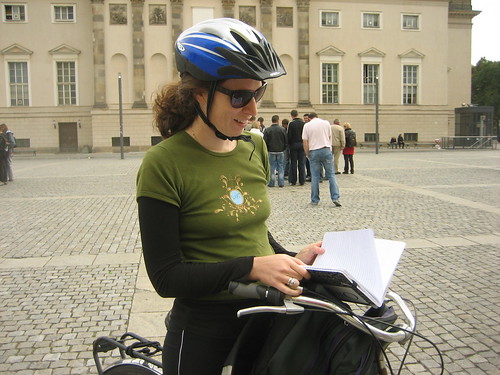 (On the Bebelplatz, site of the infamous Nazi book-burning. Yes, I'm taking notes. I'm a nerd and I'm not ashamed of it.)I got plenty of photos of drunken debauchery that night (other people's, not ours, mind you), but I think I'll just show you this one:
(On the Bebelplatz, site of the infamous Nazi book-burning. Yes, I'm taking notes. I'm a nerd and I'm not ashamed of it.)I got plenty of photos of drunken debauchery that night (other people's, not ours, mind you), but I think I'll just show you this one: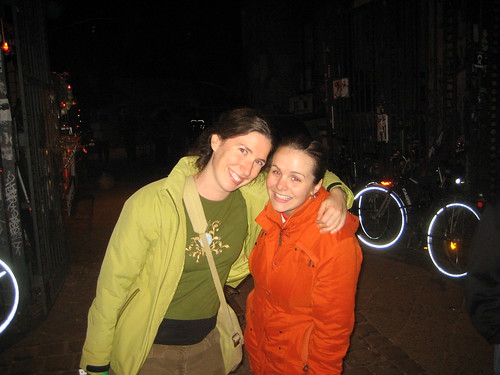 And a few more landmarks we passed on our bikes:
And a few more landmarks we passed on our bikes: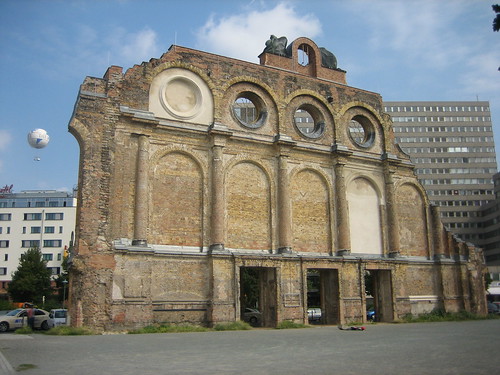 The ruins of Anhalter Station, once Berlin's central train terminal.
The ruins of Anhalter Station, once Berlin's central train terminal.
Obama made his July 24th speech at the foot of the Siegessäule, the Victory Column, which is at the center of an enormous roundabout. Hooray for digital zoom! (There's a much better close-up on the Wikipedia page.)
Knocknarea
There is an epic suggestiveness which you cannot miss if you climb the mountain. You cannot keep your hold upon the present while you are up there.
A 45-minute plod up Knocknarea (from the Irish Cnoc na Rí), at an elevation of 329m, brings you to an enormous cairn known as Queen Maeve's Tomb. Here it is, blanketed in mid-morning fog:
We walked up here last weekend with a few of Brendan's friends. The cairn is 55m wide and 10m high, and likely dates to the beginning of the third millennium B.C. It's never been excavated, but archaeologists speculate that the whole thing weighs 40,000 tons, and that there might be a passage tomb underneath on par with Newgrange. Forty thousand tons and counting, because people follow the tradition of bringing a stone from the bottom of the hill to drop on the cairn. Actually, according to the lovely lady who runs the B&B we stayed at (Pearse Lodge, on Pearse Road, a ten-minute walk from town--definitely getting "top pick" in the second edition), the original tradition was to take a stone away from the cairn. Obviously that couldn't go on indefinitely, so the Tourist Board reversed the tradition! There are similar traditions associated with lots of other mountains around the country.
The view from the summit has to be awesome, but both times I've visited it's been too foggy to see anything. These shots were taken on the way down (in the first one everybody is taking turns shouting into the valley and waiting for the echoes):
Sligo is beautiful, isn't it?
Here Lyeth the Boby
HUZZAH!!!!!!!!!!!!!!!!!!!!!!!!!!!!!!!!!!!!!(Now back to your regularly-scheduled blog entry.)
Brendan and I spent the weekend in Sligo, where I did a bit of research for the second edition of Moon Ireland. Most visitors come to pay homage to William Butler Yeats, who is buried in the graveyard at Drumcliff not far outside town, at the church where his great-grandfather was rector. We, on the other hand, came to socialize, shop for wooly goodness from County Donegal, climb up Knocknarea (pictures next post), and listen to Renaissance choral music in the ruins of Sligo Abbey. It was awesome. Here are some of my best shots from the abbey.
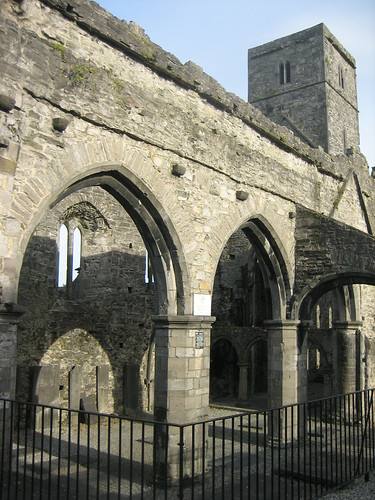
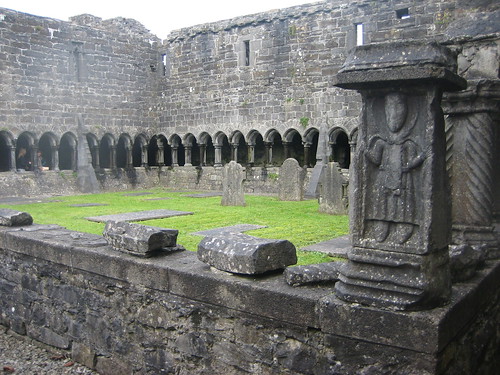 And here's a shot from the concert, which was actually part of a larger project by English filmmaker Sonia Boyce (you can see her with her camera on the bottom left of the photo below. Notice, too, how the choral director is standing on a grave slab.) A "sound artist" made shrieking and humming sounds to form a sort of "dialogue" with the choral singers. (You can't see him in this shot, but he was wearing jagged cardboard wings, a sort of white neck-dress, and a white robe. This element of the performance was somewhat pretentious, but I enjoyed it regardless.) The choral group is UK-based Alamire, and you can see a clip from the video installation here.
And here's a shot from the concert, which was actually part of a larger project by English filmmaker Sonia Boyce (you can see her with her camera on the bottom left of the photo below. Notice, too, how the choral director is standing on a grave slab.) A "sound artist" made shrieking and humming sounds to form a sort of "dialogue" with the choral singers. (You can't see him in this shot, but he was wearing jagged cardboard wings, a sort of white neck-dress, and a white robe. This element of the performance was somewhat pretentious, but I enjoyed it regardless.) The choral group is UK-based Alamire, and you can see a clip from the video installation here.
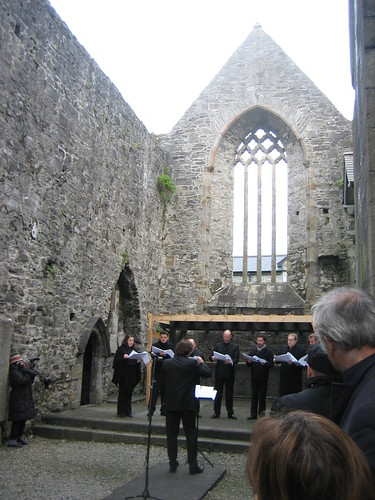 The abbey itself was a real treat too. The last time I visited Sligo was during the week in wintertime, so I wasn't able to visit it. The cloister and Gothic and Renaissance tombs are all remarkable, and I got a macabre history lesson from one of the guides behind the front desk. The buildings have a sunken appearance, he said, because of all the people buried in the surrounding graveyard during the cholera epidemic of 1832. Fearing ongoing contagion, church leaders closed the abbey graveyard and opened a new one a mile outside town; but this land was so sacred to the Catholics of Sligo that they would go back to the new cemetery late at night to exhume their relatives and rebury them here. It had to be done hastily and without the aid of a lantern, so that body parts were often seen protruding from the earth. All these shallow graves led to a rising of the earth around the abbey walls.
The abbey itself was a real treat too. The last time I visited Sligo was during the week in wintertime, so I wasn't able to visit it. The cloister and Gothic and Renaissance tombs are all remarkable, and I got a macabre history lesson from one of the guides behind the front desk. The buildings have a sunken appearance, he said, because of all the people buried in the surrounding graveyard during the cholera epidemic of 1832. Fearing ongoing contagion, church leaders closed the abbey graveyard and opened a new one a mile outside town; but this land was so sacred to the Catholics of Sligo that they would go back to the new cemetery late at night to exhume their relatives and rebury them here. It had to be done hastily and without the aid of a lantern, so that body parts were often seen protruding from the earth. All these shallow graves led to a rising of the earth around the abbey walls.
I had heard that Bram Stoker's work was influenced by the horrors of that epidemic. More from Sligo: A Short History:
People were left dead in the streets and whole families were wiped out. Bram Stoker (the author of Dracula) had his macabre imagination fired by his mother, a Sligo woman, who told stories of coffin makers knocking on doors in the night looking for corpses and of victims being buried alive.
The guide told me that the dying were often left unconscious in open graves. The people who left them there were, of course, afraid of contracting the disease themselves. He said there was zero chance that these victims could recover...but what if they should wake up before they died? Too horrible to contemplate.Here's another item of interest from the abbey floor:
Why were James's family name and details effaced? It's possible he brought some sort of shame upon his family, or that his remains were reinterred elsewhere. Most interesting to me was the curious spelling of "body." According to the abbey brochure, the average stonecarver was illiterate.
Adventures in Germany: Quedlinburg
After three nights in Wernigerode, Kelly and I made an afternoon stop at Quedlinburg on our way back to Berlin. This town on the north-eastern edge of the Harz was one of the reasons I had wanted to come to Germany in the first place. I was struck by this passage in Resisting Hitler, a biography of the American scholar, communist, and German resistance member Mildred Harnack-Fish:
A romantic and evocative region abounding in medieval cathedrals and squares, the Harz has many literary associations, particularly with Heine and Goethe. On a postcard to Falk, Mildred wrote that "the beauty of the mountains, the rivers and forests under the great sun is powerful...Every evening we read Faust I together. It fits these surroundings." Mildred particularly liked Quedlinburg, with its schloss and Romanesque cathedral perched on a sandstone cliff. But it was the wild grandeur of the valley of the Brocken, with granite slopes that bore names like the "Witches Washbasin," "Devil's Pulpit," and finally the "Witches' Dancing place"--where each year on the Witches' Sabbath, Walpurgis Night, the spirits gathered--that formed the romantic backdrop for their nightly readings. "You can only appreciate the landscape of the Harz if you go by foot as Goethe has done," she enthused on a postcard to her mother-in-law.
Mildred Harnack-Fish was a member of the so-called Red Orchestra, a group of pro-Soviet/anti-Nazi Germans who attempted radio contact with Moscow. (Harnack-Fish had met her husband at the University of Wisconsin, and returned with him to Germany.) Because many of them had joined the Nazi party and held influential positions in government, they had loads of intelligence to share with the Soviets. For the most part, though, their contacts in Moscow were too inept to make use of it, and of course the Gestapo had intercepted the messages anyway. The round-up began at the end of August 1942, and Mildred and Arvid Harnack were arrested while on holiday at a lake north of Berlin. She was beheaded by the Nazis in February 1943--the only American woman Hitler personally ordered put to death. Shareen Blair Brysac's biography is excellent.Anyway, when we first arrived in Quedlinburg I wasn't quite as enthused as Mildred was, but that was only because we'd arrived by train and the Quedlinburg train station is pretty gross. (No one had emptied the trash receptacles in quite some time, and there was rubbish all over the floor. The place was run-down in general, and contrary to Lonely Planet's report, there weren't any lockers where we could stash our packs.)Once we got into town, though, our opinion of the place improved. The center of Quedlinburg is just as atmospheric and charming as Wernigerode's, and the Schloss and Cathedral (the Lutheran Church of St. Servatius) are well worth a visit (the treasury has a strange wartime history of its own--see the Quedlinburg Art Affair, in which an American army lieutenant absconded with many of these treasures that had been hidden in a mine-shaft for safekeeping.)And of course, there were more of those quaint half-timbered townhouses slanting at weird angles:
 And here are a few shots of the Rathaus (Town Hall), the church and castle on the aforementioned sandstone cliff, and a cute picture of my dear travel buddy on the castle terrace overlooking the town:
And here are a few shots of the Rathaus (Town Hall), the church and castle on the aforementioned sandstone cliff, and a cute picture of my dear travel buddy on the castle terrace overlooking the town:
Next up in my Germany photo series is the East Side Gallery, but I'll be blogging about my weekend in Sligo first.
Autumn in NJ, part 2
(Autumn in New Jersey, part 1.)
In New Jersey I live a pleasant fifteen-minute walk from the local library, where I do a lot of my writing. I was on my way there last week, still enjoying the fall foliage, when what should emerge from these woods...
 ...but a pair of deer! They sprinted across these fields and then bore left, back towards the trees.
...but a pair of deer! They sprinted across these fields and then bore left, back towards the trees.
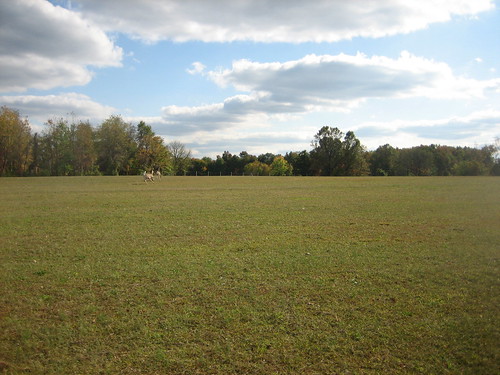 I live in what feels like a heavily populated area, so this wildlife sighting was a real delight. It made my day.
I live in what feels like a heavily populated area, so this wildlife sighting was a real delight. It made my day.
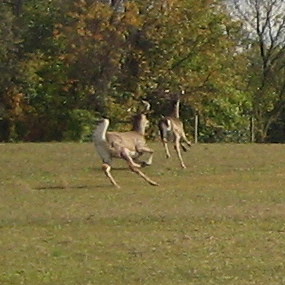 Quedlinburg next time. For real!
Quedlinburg next time. For real!
Autumn in New Jersey
I know, I know, I've fallen down on the job--there are still so many more photos from Germany to share! I'm back in Jersey until October 19th, and it's been really busy around here with my aunt Debbie (from Arizona) and our cousins from Italy coming and going. The weather has been absolutely gorgeous lately, and the fall foliage is stunning. Here are a few pics from my neighborhood.
Adventures in Germany: the Brocken
(Woohoo! We have wireless!)The day after we visited the Schloss, we took the Harz narrow-gauge railway up to the tallest peak in northern Germany, the Brocken. The vintage train wound its way through seemingly endless swathes of evergreen forest, the fog getting heavier as we ascended. You could totally see why there are so many legends about witchcraft in the area.
As we figured, the journey was far more enjoyable than the destination itself. The Brocken is not an attractive mountain--it reminds you of a bald man's pate more than anything else--and there's a transmission tower and hotel up there to boot. There was so much rain and fog when we got up there that all we could see were a couple of souvenir stands (with instant coffee at outrageous prices) and a 'restaurant' right beside the train station. We went to the loo and got straight back on the train for the return trip.
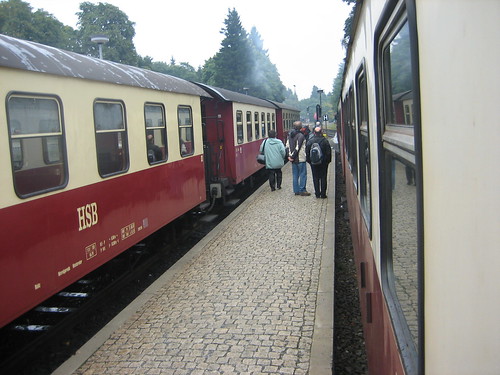
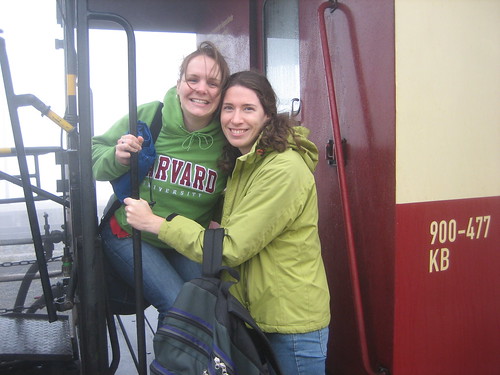
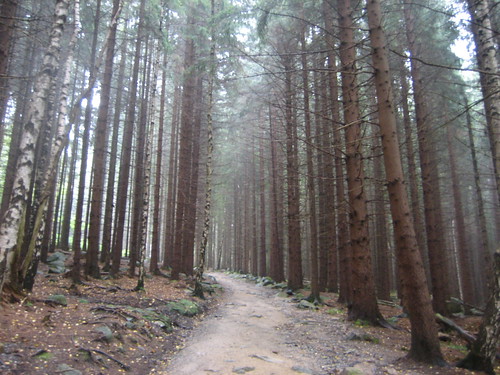 On the way back, we got off at Schierke and walked through the forest and into the village looking for a café, which was more of a challenge than we were expecting--plenty of eateries but none of them open. Finally found a nice little bakery-café where we got coffee and some sweet nibbly things.
On the way back, we got off at Schierke and walked through the forest and into the village looking for a café, which was more of a challenge than we were expecting--plenty of eateries but none of them open. Finally found a nice little bakery-café where we got coffee and some sweet nibbly things.
After coffee and a bit of shopping in town (Ritter Sport chocolate for 85¢, weeeeeeeeeeeee!), we made our way back to the station through the forest, and took the next train back to Wernigerode. It was a really fun day, with the air of a field trip about it.Oh, and here's the view out our hotel window:
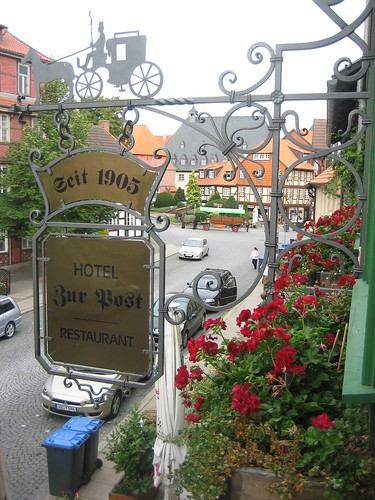 If you're ever in Wernigerode, stay at the Hotel Zur Post on Marketstrasse. It's family-run, everyone there is really friendly (they don't speak more than a few words of English, but they were so patient with us as we tried to speak the dozen words of German we had between us), and the restaurant food was top-notch (and very veggie-friendly).
If you're ever in Wernigerode, stay at the Hotel Zur Post on Marketstrasse. It's family-run, everyone there is really friendly (they don't speak more than a few words of English, but they were so patient with us as we tried to speak the dozen words of German we had between us), and the restaurant food was top-notch (and very veggie-friendly).
Next post: Quedlinburg!
